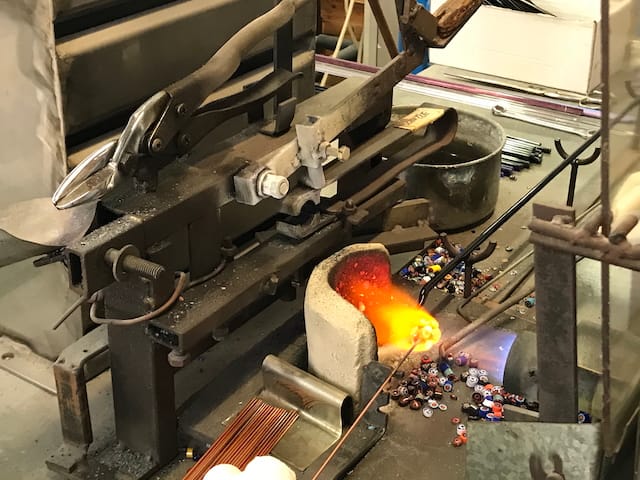Hot Glass, but a Cooler Climate
Glass blowing, an ancient art that has always had a dreadful carbon footprint, finds ways to improve.

Hand-blown glass is impossible without heat. Loads and loads of heat, because melting glass is more-or-less the same as melting rock.
Heat spills out all over the place, so much heat that managing it properly is significantly difficult. We know of glass "hot shops" that operate with the doors open in the middle of a frigid Canadian winter, while all the people inside are sweating, dressed only in t-shirts and jeans.
Glass blowers start at a furnace filled with a pool of molten glass, drawing it out with a rod or pipe. If the glass cools too much, it becomes unworkable, so glass artists repeatedly re-heat pieces in a "glory hole", a barrel-shaped blast furnace fitted with an openable door on one end. The artists may use a hand torch to provide spot heat to specific places on a piece as they work to keep the glass malleable, to make it sticky so new hot bits (like handles on a mug) can be put on, and to keep the temperature up while they work it. Glass that gets too cold too quickly can fall off the blowing pipe onto the floor, or even shatter in place.
"Loads and loads of heat" has traditionally come from loads and loads of carbon-based fuel. Since Roman times, hot shops have burned massive quantities of hardwood to reach the temperatures of 1,600 degrees Celsius needed in a glass furnace. Venice and Murano glass blowers burned through so much local hardwood that they exceeded the capabilities of local forests to regenerate. That was a real problem in an area known for shipbuilding as much as for glass.
Wood, coal, natural gas, propane ... hot shops have used—and continue to use—any carbon-based fuel that can reach temperatures high enough to make glass. But that is changing.
The modern glassblowing industry has begun to embrace new approaches: process auditing, studio-level carbon metrics, and industry benchmarking have aided glassblowers who want to lower the carbon footprints of their products.
Glass furnaces (the biggest fuel hogs in glass shops) are getting smaller, better-insulated, and operated by sophisticated computer algorithms that melt glass electrically. Where combustion fuels must still be used, pure oxygen can be injected to drop emissions drastically.
Glory holes can't always be smaller, since they are typically sized for the pieces they make, but they can be electrified or use biofuels. They are much better insulated, programmable, and have tight-sealing doors to keep heat inside. They have expanded creative possibilities for glass artists in surprising new ways.
Bench torches can be electric, too, or use biofuels. Particularly exciting are a new generation of hydrogen torches where water is electrolyzed (using renewable energy, we hope!) to produce hydrogen and oxygen, which are burned to produce intense, high-temperature flames that are, in some ways, far superior to a hand-held gas torch. Flame purity is high and the focus is controllable. The emissions? Water. Oh, and loads and loads of heat.
How effective are these changes? One forward-thinking studio, Lava Glass in New Zealand, started with a baseline estimate of lifecycle emissions for its workshop of 90 metric tons of CO2 equivalent a year. For two years, they converted equipment and changed their work processes, as well as starting a sequestration program (fittingly, by planting trees). They have more work to do, but in 2025, Lava Glass was certified as a carbon-neutral facility.1 The first, as far as we know.
Now that ... is impressive.
Reading
- “New Zealand Glass Studio Achieves Carbon Zero Certification.” n.d. Contemporary Glass Society. Accessed July 15, 2025. https://cgs.org.uk/news/new-zealand-glass-studio-achieves-carbon-zero-certification/.
